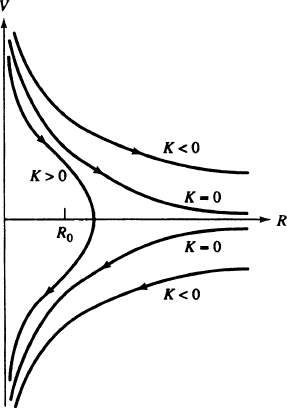Taylor M.E. Partial Differential Equations III: Nonlinear Equations
Подождите немного. Документ загружается.


668 18. Einstein’s Equations
Now u
j
Ik
D @
k
u
j
C
j
`k
u
`
,where
j
`k
isgivenby(2.9). When u has the form
(6.61), then u
k
u
j
Ik
D u
0
u
j
I0
D .@
0
u
j
C
j
00
u
0
/u
0
. Also, by (2.9),
j
00
D
U
j
00
C B
j
00
, and by (2.10), B
j
00
D 0, while (2.43) implies
(6.68)
U
0
00
D 0;
U
1
00
D
1
2
r
e
:
Thus, when u has the form (6.61),
(6.69) u
k
u
j
Ik
D
1
2
r
e
ı
j1
:
Now, in the static, spherically symmetric case, D .r/ and p D p.r/, so clearly
L
u
. Cp/ D u
0
@
0
. Cp/ D 0, and the only nontrivial component of the left side
of (6.67)is
(6.70) T
1k
Ik
D
1
2
. C p/
0
.r/e
C p
0
.r/e
:
Thus we again derive (6.66).
We can use (6.66) to eliminate
r
from the second equation in (6.63). The
result, together with the first equation in (6.63), gives a 2 2 system for .r/ and
p.r/:
(6.71)
0
.r/ D
1 e
r
8re
;
2
p C
p
0
.r/ D
1 e
r
8re
p;
under the hypothesis that D .p/. It is common to replace .r/ by a function
giving the metric (6.60) a form more resembling (2.61). We define M.r/ by
(6.72) e
.r/
D
1
2M.r/
r
1
;
so that M.r/ D r.1 e
/=2. The system (6.71) takes the form
(6.73) M
0
.r/ D 4r
2
; p
0
.r/ D
.p C /.M C 4r
3
p/
r.r 2M /
;
known as the Oppenheimer–Volkov equation.
In the Newtonian limit, p<<;4r
3
p<<M,and2M << r,andthese
equations become
(6.74) M
0
.r/ D 4r
2
; p
0
.r/ D
M
r
2
:

Exercises 669
In fact, this is precisely the equation for a static fluid in Newtonian mechanics, in
which the force of gravity exactly balances the force due to the pressure gradient.
In such a case, M.r/ is the gravitational mass of the matter enclosed in the ball
fjxjrgin R
3
. The relation between density and gravitational mass, given by the
first equation of (6.74) (in the limit when Newtonian mechanics applies) serves to
identify the constant in Einstein’s equation (1.1), with the gravitational constant
of Newtonian theory.
The Oppenheimer–Volkov system (6.73) has consequences significantly dif-
ferent from the Newtonian approximation (6.74), for very dense objects. For
example, it leads to theoretical upper bounds on the mass of a stable neutron star
which are stronger than those obtainable from (6.74). Discussions of this can be
found in [Str,Wa,Wein].
In treating (6.73), it is natural to set M.0/ D 0 and let p.0/ D p
0
run over a
range of values. We assume that p
0
./ > 0 in the equation of state, so D .p/
in (6.73), with
0
.p/ > 0. Despite the vanishing of the denominator in the second
equation of (6.73)atr D 0, there is no real singularity there. Indeed, one easily
verifies that
(6.75)
M.r/ D
4
3
0
r
3
C O.r
5
/;
p.r/ D p
0
2
3
.p
0
C
0
/.3p
0
C
0
/r
2
C O.r
4
/;
with
0
D .p
0
/. For a numerical treatment of (6.73), it is convenient to use (6.75)
for r very small, and then use a difference scheme, to produce an approximate
solution for larger r.
Exercises
1. Assume u.p/ ¤ 0 and W.p/ ¤ 0.Using(6.42), show that the linear span L
p
of u.p/
and W.p/ is given by
L
p
Dfv 2 T
p
M W
v
D 0g:
Using (6.32), show that the resulting subbundle L of TM is invariant under the flow
generated by u (in regions where u and W are both nonvanishing). In light of this,
derive analogues of the Kelvin and Helmholtz theorems, established for nonrelativistic
fluids in 5 of Chap. 16 and 1 of Chap. 17.
2. Consider a static, spherically symmetric, charged fluid and associated electromagnetic
field. Discuss the equations of motion.
3. Compute the second terms in the power-series expansions of M.r/ and of p.r/ about
r D 0 in (6.75), namely, the coefficients of r
5
and of r
4
, respectively.
4. Write some computer programs to solve numerically the Oppenheimer–Volkov system
(6.73), with initial data M.0/ D 0; p.0/ D p
0
. Try various equations of state, such as
(6.76) p./ D k
4=3
;

670 18. Einstein’s Equations
with k D const., used in models of white dwarf stars. For another example, fix
0
2
.0; 1/, and use
(6.77)
p./ D
1
3
; for
0
;
p./ D k
4=3
; for
0
;
with k picked so
0
=3 D k
4=3
0
(i.e., k D
1=3
0
=3).
See [Str]and[Wein] for discussions of variants of (6.77) used in models of neutron
stars.
5. Suppose the equation of state were
(6.78) p./ D
3
for all 2 R
C
. Produce a solution to (6.73)oftheform
(6.79) M.r/ D Ar; p.r/ D Br
1
;
for certain constants A; B. Relate this to the assertion that (6.78) cannot be a realistic
equation of state at low density.
7. Gravitational collapse
In many cases, solutions to Einstein’s equations, particularly coupled to matter,
develop singularities in finite time, sometimes as part of the phenomenon of grav-
itational collapse. We begin this section with some simple examples in which
gravitational collapse occurs.
Let us consider a homogeneous, isotropic universe, containing a fluid with
uniform density and pressure. We write the metric as
(7.1) ds
2
Ddt
2
C A.t/g
S
;
where g
S
is a constant-curvature metric on a 3-manifold S . The stress-energy
tensor has the form (6.2), with
(7.2) D .t/; p D p./; u D .1;0;0;0/:
We can compute the Einstein tensor of this metric using formulas from 2.We
have M D U S , where dim U D 1 and dim S D 3.From(2.22)wehave
(7.3) Ric
jk
D Ric
S
jk
C F
jk
;
and F
jk
isgivenby(2.28), with # D log A.t/. Hence (keeping in mind (2.20))
we have
(7.4) F
00
D
3
2
A
2
n
AA
00
1
2
.A
0
/
2
o
;

7. Gravitational collapse 671
and, for 1 j; k 3,
(7.5) F
jk
D
1
2
A
1
n
AA
00
1
2
.A
0
/
2
o
g
S
jk
:
By (2.29), the scalar curvature of M is
(7.6) S D A
1
S
S
C ˇ;
where
(7.7) ˇ D g
jk
F
jk
D 3A
1
A
00
:
Then, by (2.36), the Einstein tensor of M is given by
(7.8) G
jk
D G
S
jk
C
1
2
A
1
S
S
ı
j0
ı
k0
C F
jk
1
2
ˇg
jk
:
In particular,
(7.9) G
00
D
1
2
A
1
S
S
C F
00
C
1
2
ˇ D
1
2
A
1
S
S
C
3
4
.A
1
A
0
/
2
;
and, for 1 j; k 3,
(7.10) G
jk
D G
S
jk
C F
jk
3
2
A
00
g
S
jk
D G
S
jk
n
A
00
1
4
A
1
.A
0
/
2
o
g
S
jk
:
Now, if S has constant sectional curvature (and hence constant scalar curvature
S
S
), then
S
Ric
j
k
must be a scalar multiple of ı
j
k
, and the multiple must be
S
S
=3,so
(7.11) G
S
jk
D
1
6
S
S
g
S
jk
:
If T
jk
is given by (7.2), then Einstein’s equations yield the following pair of
equations for A.t/ and .t/:
(7.12)
3
4
A
0
A
2
C
1
2
S
S
A
D 8;
A
00
1
4
.A
0
/
2
A
C
S
S
6
D8Ap./:

672 18. Einstein’s Equations
To put this in a slightly different form, we set A.t/ D R.t/
2
and note that if S has
constant sectional curvature K,thenS
S
D 6K. The we can rewrite (7.12)as
(7.13)
.R
0
/
2
C K D
8
3
R
2
;
2RR
00
C .R
0
/
2
C K D8p./R
2
:
It is useful to perform some elementary operations on these equations. Note that
taking the difference yields
(7.14) 3
R
00
R
D4. C 3p/;
while multiplying the first equation in (7.13) by 3 and taking the difference yields
(7.15)
d
dt
R
0
R
D
K
R
2
4. C p/:
On the other hand, applying d=dt to the first part of (7.13)gives
(7.16)
d
dt
D6K
R
R
3
C 6
R
0
R
d
dt
R
0
R
;
and substituting (7.15)into(7.16)thengives
(7.17)
d
dt
.R
3
/ Dp
d
dt
.R
3
/:
One can also deduce (7.17) from the identity T
jk
Ik
D 0 (with j D 0), in a fashion
analogous to the derivation of (6.66)via(6.67)–(6.70). In turn, (7.17) implies the
relation
(7.18)
dR
R
D
1
3
d
C p./
;
which gives R as a function of ,or as a function of R.
Let us fix R
0
D R.t
0
/ and
0
D .t
0
/. We can now regard (7.14) as a dynam-
ical equation for R:
(7.19) R
00
D
4
3
'.R/; '.R/ D . C 3p/R ;
given and p./ as functions of R, and then the first part of (7.13) can be regarded
as the conservation law:
(7.20)
1
2
.R
0
/
2
4
3
.R/ DK; .R/ D R
2
:

7. Gravitational collapse 673
In other words, if we write (7.19) as a first-order system:
(7.21) R
0
D V; V
0
D
4
3
'.R/;
then the orbits lie on level curves
(7.22) F.V;R/ DK; F.V; R/ D
1
2
V
2
4
3
.R/:
Thus we will examine these level curves.
To do this, we look at (7.18), which gives
(7.23) R D R
0
e
./=3
;./D
Z
0
d
C p./
:
If we assume that the equation of state satisfies
(7.24) p.0/ D 0; p
0
./ 1;
then (if say
0
D 1)for 1,wehave.1=2/ log ./ log ,
so R
0
1=3
R R
0
1=6
, with reversed inequalities for 1. Hence
.R
0
=R/
3
.R
0
=R/
6
for 1,so .R/ has the property
(7.25) R R
0
H)
R
3
0
R
.R/
R
6
0
R
4
:
Similarly,
(7.26) R R
0
H)
R
6
0
R
4
.R/
R
3
0
R
:
In Fig. 7.1 we depict the level curves of F.V;R/and the resulting phase-plane
portrait of the system (7.21). Note that all the orbits .R.t/; V .t// in the region
V<0have the property R.t/ & 0; V .t/ &1,ast increases. In particular, if
V.t
0
/<0,thenR
0
.t/ is bounded away from zero for t t
0
,soR.t/ must reach
zero at a finite time t
1
>t
0
Š Similarly, if V.t
0
/>0,thenR.t/ must vanish for
some finite t<t
0
. Of course, at R D 0; DC1, and the metric is singular. If
K>0, one must have a singularity both at a finite time before t
0
and at a finite
time after t
0
.IfK 0, there must be such a singularity either at some finite t<t
0
or at some finite t>t
0
.
That such complete collapse must occur is not surprising in the case of a dust,
where p D 0. However, it is striking that, given any realistic equation of state, the
pressure cannot prevent the collapse to infinite density, even in the case K>0
and the total amount of matter in the universe is finite.

674 18. Einstein’s Equations
FIGURE 7.1 Orbits for (7.21)
One can cut and paste a portion of some of the spacetimes described above with
a portion of Schwarzschild spacetime to give a model of collapse of a star, with
spherical symmetry. The collapse of a rotating star is much more complicated. For
further discussion, see [MS] and references given therein. It is worth mentioning
the widely held belief that such a collapse, generally accompanied by gravitational
radiation, should rapidly approximate a Kerr solution.
There are a number of general results on the inevitability of gravitational col-
lapse, accompanied by singularity formation. A detailed treatment is given in
[HE], and we mention only one relatively simple case here. We show that un-
der certain mild conditions, an irrotational dust must give rise to a singularity in
spacetime. We begin with a pair of geometrical lemmas.
Lemma 7.1. If u is a vector field satisfying
(7.27) hu; uiD1; r
u
u D 0; A
u
D A
u
;
then
(7.28) L
u
.div u/ DRic.u; u/ Tr A
2
u
:
Proof. Let fe
j
W 1 j 3g be a local orthonormal frame field for †, the bundle
of 3-planes orthogonal to u.Then(6.16) yields
(7.29) L
u
.div u/ Dhr
u
r
e
j
u;e
j
iChr
e
j
u; r
u
e
j
i:

7. Gravitational collapse 675
Here and below, we use the summation convention. Now write the first term on
the right side of (7.29)as
(7.30)
hr
u
r
e
j
u;e
j
iDhr
e
j
r
u
u;e
j
iChr
Œu;e
j
u;e
j
iChR.u;e
j
/u;e
j
i
DhA
u
Œu;e
j
; e
j
i Ric.u; u/;
using r
u
u D 0.IfA
u
D A
u
,wehave
(7.31)
hr
e
j
u; r
u
e
j
ihA
u
Œu;e
j
; e
j
iDhA
u
e
j
; r
u
e
j
C Œu;e
j
i
DhA
u
e
j
;A
u
e
j
i2hA
u
e
j
; r
u
e
j
i;
since Œu;e
j
Dr
u
e
j
r
e
j
u.
The expression hA
u
e
j
;A
u
e
j
i (summed over j ) is equal to Tr A
2
u
if A
u
D
A
u
.Furthermore,
hA
u
e
j
; r
u
e
j
iDA
jk
he
k
; r
u
e
j
i;
where .A
jk
/ is the matrix of A
u
, with respect to the basis fe
j
g, which is symmet-
ric. Since he
k
; r
u
e
j
i is antisymmetric in .j; k/, we deduce that hA
u
e
j
; r
u
e
j
iD0
(summed over j ). This proves (7.28).
Recall from Lemma 6.1 that A
u
D A
u
is an integrability condition, and, by
Lemma 6.2, it is equivalent to vanishing vorticity. Note that if A
u
D A
u
,then
Tr A
2
u
1
3
.Tr A
u
/
2
;
as can be seen by putting A
u
in diagonal form. Using (6.15), we can deduce the
following:
Lemma 7.2. Under the hypotheses of Lemma 7.1,
(7.32) L
u
.div u/
1
3
.div u/
2
Ric.u; u/:
Proposition 7.3. Suppose M is a spacetime containing a dust, so the Einstein
equations hold, with T
jk
given by
(7.33) T
jk
D u
j
u
k
;
with 0 and hu; uiD1. Assume that the motion of the dust is irrotational.
Finally, assume that, for some p 2 M ,
(7.34) div u.p/ Db<0:

676 18. Einstein’s Equations
Let be the orbit of u (a unit-speed geodesic) such that .0/ D p.If./ is
defined for 2 Œ0; a/,thena 3=b.Furthermore,ifa D 3=b,then
(7.35)
./
!C1 and S
./
!C1; as % a:
Proof. Under our hypotheses, Corollary 7.2 applies, so we have (7.32). Also, by
(1.61),
(7.36) Ric.u; u/ D 4;
which is 0. Hence,
(7.37) f./ D div u..// H) f
0
./
1
3
f./
2
;
so the hypothesis (7.34) implies
(7.38) f./
3b
3 b
;
for 0 <a, provided f./is smooth on Œ0; a/. This shows that a 3=b.Also,
if a D 3=b,thenf./ !1as % a,insuchafashionthat
(7.39)
Z
a
0
f./d D1:
To conclude the proof of (7.35), note that, given a dust, by (6.5)wehave
div.u/ D 0, hence L
u
C div u D 0,or
L
u
.log / Ddiv u; i.e.,
d
d
log ..// Df./:
Hence (7.39) implies the first part of (7.35). By (1.59)wehave
S D 8;
so the second part of (7.35) also holds.
Exercises
1. Obtain more explicit solutions to (7.13) for a dust (i.e., when p D 0). (Hint:Use(7.17).)
2. Assume p D 0.LetM have a metric of the form (7.1), by solving (7.12). Let B be
a ball in the 3-manifold S,usedin(7.1), and let be the subset of M formed by
timelike geodesics through @B , orthogonal to S .Glue to an appropriate piece of
Schwarzschild spacetime (whose boundary is also swept out by timelike geodesics)
so as to model the collapse of a dust ball. In what sense do (6.1)and(6.2)holdona
neighborhood of the interface?

8. The initial-value problem 677
3. Consider the behavior of a homogeneous, isotropic universe filled with a uniform fluid
(i.e., consider solutions to (7.12)), when one does not require that the equation of state
satisfy p
0
./ 1.
8. The initial-value problem
To begin, we look at the initial-value problem for the empty-space Einstein equa-
tions, which can be written as
(8.1) Ric
jk
D 0:
In our first formulation of the initial-value problem, we try to prescribe, on a
3-dimensional surface S Dfx
0
D 0gM , the initial data
(8.2) g
jk
ˇ
ˇ
S
D
ı
g
jk
;@
0
g
jk
ˇ
ˇ
S
D
ı
k
jk
:
Here, @
0
D @=@x
0
.TakeM open in R
4
;SD M \fx
0
D 0g. We will see shortly
that compatibility conditions will be required on these data. In local .x
0
;:::;x
3
/-
coordinates we have
(8.3)
Ric
jk
D
1
2
g
`m
@
`
@
m
g
jk
@
j
@
k
g
`m
C @
k
@
m
g
`j
C @
`
@
j
g
km
C M
jk
.g; rg/
D L
jk
.g; D/g CM
jk
.g; rg/:
Now it is easy to see that S Dfx
0
D 0g is characteristic for L. This results
from the coordinate independence of the condition (8.1). We can get around this
problem by choosing coordinate systems of a special nature.
One way to do this is the following, used by [CBr2], following [Lan]. Rewrite
(8.3)as
(8.4) Ric
jk
D
1
2
g
`m
@
`
@
m
g
jk
C
1
2
g
j`
@
k
`
C
1
2
g
k`
@
j
`
C H
jk
.g; rg/;
where
(8.5)
`
D g
jk
`
jk
D
1
2
g
jk
g
`m
@
k
g
jm
C @
j
g
km
@
m
g
jk
;
and the
`
jk
are the Christoffel symbols for the metric tensor .g
jk
/, in the coordi-
nates .x
0
;:::;x
3
/.If is the Laplace–Beltrami operator defined by the Lorentz
metric .g
jk
/,then
(8.6) u D g
jk
u
Ij Ik
D g
jk
@
j
@
k
u
`
@
`
u:
